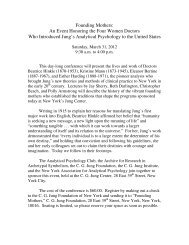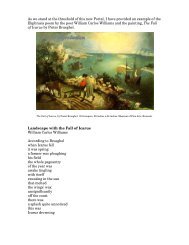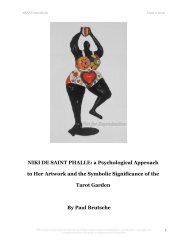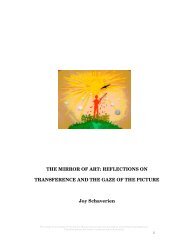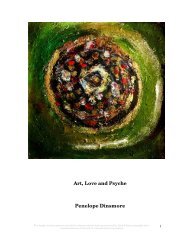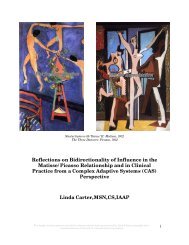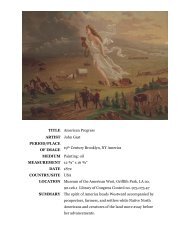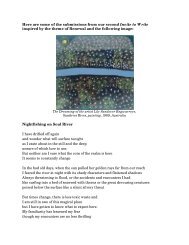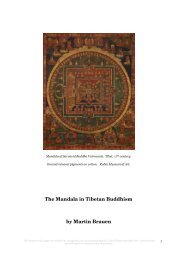Pictorial Space throughout Art History: Cézanne and ... - ARAS
Pictorial Space throughout Art History: Cézanne and ... - ARAS
Pictorial Space throughout Art History: Cézanne and ... - ARAS
You also want an ePaper? Increase the reach of your titles
YUMPU automatically turns print PDFs into web optimized ePapers that Google loves.
<strong>ARAS</strong> Connections Issue 2, 2012<br />
Conclusion<br />
The parallels between Winnicott's interior space, Jung's individuation <strong>and</strong><br />
pictorial space are too deep to be mere analogies. An evolving personality <strong>and</strong> an<br />
evolving plastic painting are apparently homologous systems organized according<br />
to a common set of principles (6) |67|. A plastic painting makes tangible a<br />
process which, in the personality, is slow <strong>and</strong> obscure: it models or symbolizes<br />
the structure towards which individuation tends. In part, this is why it moves us<br />
so deeply. Plastic art was first created more than 35,000 years ago. Just as we<br />
have always used myth to represent the inner life, so we have always used plastic<br />
art for the same purpose.<br />
Two writers on unity<br />
The body of the universe was created to be at unity owing to proportion;<br />
in consequence it acquired concord, so that having once come together in<br />
unity with itself it is indissoluble by any but its compounder ... his<br />
purpose being, firstly, that it should be as complete a living being as<br />
possible, a whole of complete parts<br />
- Plato, Timaeus<br />
The neo-Platonic view of art conceived the artist as planning his work of<br />
art according to a preexisting system of proportion, as a 'symphonic'<br />
composition, ruled by a 'dynamic symmetry' corresponding in space to<br />
musical eurhythmy in time. This technique of correlated proportions was<br />
in fact transposed from the Pythagorean concept of musical harmony: the<br />
intervals between notes being measured by the lengths of the strings of<br />
the lyre ... so that the chords produce comparisons or combinations of<br />
ratios, that is, systems of proportions.<br />
- Matila Ghyka: The Geometry of <strong>Art</strong> <strong>and</strong> Life |68|<br />
The images in this paper are strictly for educational use <strong>and</strong> are protected by United States copyright laws. 72<br />
Unauthorized use will result in criminal <strong>and</strong> civil penalties.



